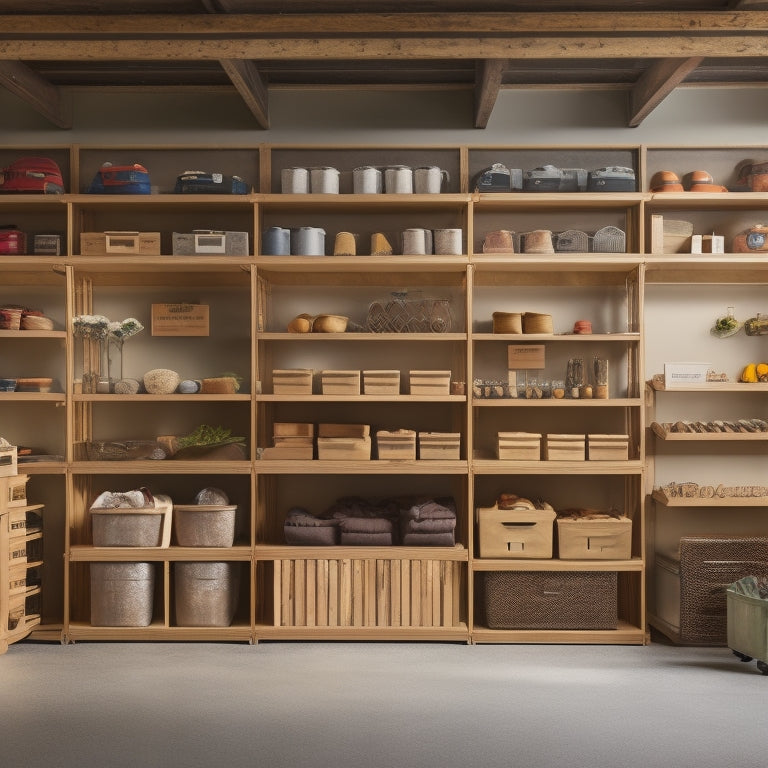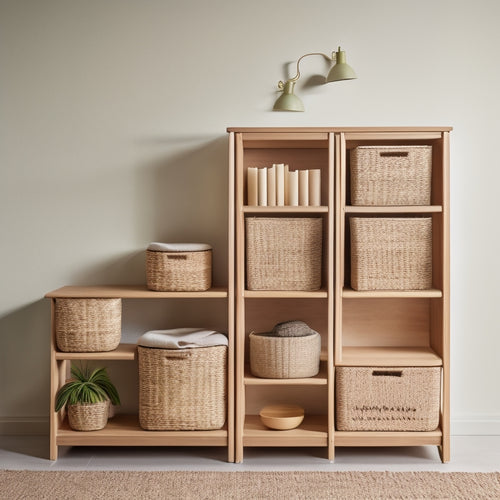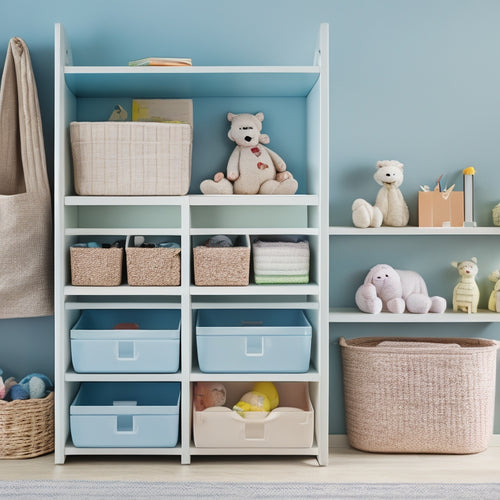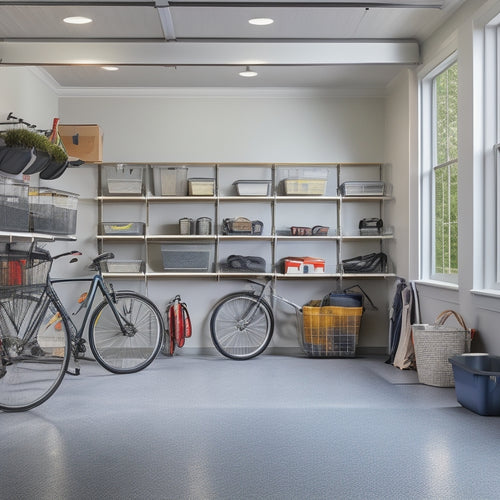
Shelving for Storing and Displaying Storage Totes
Share
When selecting shelving for storing and displaying storage totes, consider factors like load capacity, material durability, and adjustability to accommodate varying tote sizes. Measure the installation area and tote dimensions accurately to guarantee a perfect fit. Choose shelving materials that blend with your decor without sacrificing functionality, and prioritize durability and safety. For small spaces, look for space-saving designs and modular units that maximize vertical storage. By considering these factors, you'll create an efficient and organized storage system - and with a few more considerations, you'll be able to optimize your shelving unit for maximum functionality and visual appeal.
Key Takeaways
- Choose shelving materials that balance strength, durability, and aesthetics, such as metal, wood, or composite, to support storage totes.
- Measure the installation area and storage totes accurately to ensure a perfect fit and safe storage setup.
- Select shelving units with adjustable shelves to accommodate varying tote sizes and maximize vertical storage space.
- Consider compact storage solutions like modular shelving, vertical storage, and multi-functional units for small spaces.
- Prioritize safety and stability by anchoring shelving units to walls and maintaining regular maintenance checks to prevent damage and collapse.
Choosing the Right Shelving Type
With storage totes piling up, finding the right shelving type is vital to maximize your storage space and keep your belongings organized. You need to take into account shelving aesthetics to guarantee the shelving unit blends seamlessly with your existing decor.
However, don't compromise on functionality for the sake of style. It's important to prioritize load capacity, as it directly affects the safety of your stored items and the shelving unit itself. A shelving unit with a high load capacity can withstand the weight of your storage totes, preventing collapse or damage.
When selecting a shelving type, think about the material, design, and features. For instance, metal shelving units are durable and can support heavy loads, while wooden shelving units offer a more rustic aesthetic.
Look for shelving units with adjustable shelves to accommodate storage totes of varying sizes. Additionally, take into account shelving units with built-in safety features, such as anti-tip brackets or wall anchors, to prevent the unit from tipping over.
Measuring for Perfect Fit
Now that you've selected the ideal shelving type, it's time to confirm a perfect fit in your storage space. Measuring your space accurately is vital to guarantee safe and efficient storage of your totes.
Start by measuring the length, width, and height of the area where you plan to install the shelving. Consider the dimensions of the totes you'll be storing, including their height, width, and depth. This will help you determine the ideal shelf height and spacing for easy tote accessibility.
Measure the doorways, hallways, and any other obstacles that may affect the installation or usage of the shelving. Take note of any electrical outlets, pipes, or other obstacles that may impact the shelving's placement.
Record all your measurements to confirm accuracy and refer to them when installing your shelving. By doing so, you'll be able to create a safe and functional storage space that meets your needs.
Shelving Materials and Durability
Five primary shelving materials are commonly used for storing totes: wood, metal, plastic, composite, and wire. Each material has its own strengths and weaknesses, which you should consider when selecting shelving for your storage totes.
You'll want to choose a material that can support the weight of your totes. Load capacity is a critical factor in guaranteeing the safety and stability of your shelving unit. Metal and wire shelving tend to have higher load capacities than wood or plastic, making them ideal for heavy or bulky totes.
Composite shelving, a hybrid of materials, often offers a balance between strength and affordability.
Durability is also essential. Wood shelving can be prone to warping or cracking, while plastic shelving may be more susceptible to scratches or breaks. Metal and wire shelving are generally more resistant to damage, but may rust or corrode if not properly coated or maintained.
Storage Tote Size Considerations
When selecting storage totes, you'll need to take into account the dimensions of the totes to guarantee they fit comfortably on your shelves.
You'll find that totes come in standard sizes, but it's crucial to measure your space to determine the maximum size that will work for you.
Tote Dimensions Matter
Your storage totes come in various shapes and sizes, but it's essential to take into account their dimensions when selecting shelving. You need to guarantee the shelving can accommodate the length, width, and height of your totes. Failure to do so may result in unstable stacking, which can lead to accidents and damage to your stored items.
When considering tote dimensions, think about the tote weight as well. Heavier totes require sturdier shelving to prevent collapse. You should also consider tote stacking, as some totes are designed to be stacked on top of each other while others are not. Knowing the maximum weight capacity of your shelving and the weight of your totes will help you determine the ideal stacking configuration.
Additionally, you should measure the openings of your totes to confirm they can be easily removed and replaced on the shelving. Properly sized shelving will prevent your totes from getting stuck or damaged, making it easier to access and store your items.
Standard Size Options
Pick from a range of standard size options to guarantee your storage totes fit snugly on the shelving.
You'll find that most shelving systems cater to popular standard tote sizes, such as 12 inches wide, 18 inches wide, and 24 inches wide. These sizes accommodate a variety of tote weights, ensuring safe storage and easy retrieval.
When selecting a shelving system, consider the tote weight capacities you need. For instance, if you're storing heavy equipment or tools, you may require shelving with a higher weight capacity, such as 50 pounds per shelf or more.
On the other hand, lighter items like linens or cleaning supplies may only require shelving with a lower weight capacity, around 20-30 pounds per shelf.
Measuring Your Space
Several key measurements are essential to determining the ideal shelving configuration for your storage totes. You'll need to take precise space dimensions to guarantee a safe and efficient storage system.
Start by measuring the width, depth, and height of the area where you plan to install the shelving unit. Make certain to record these accurate measurements in inches or feet to avoid any mistakes.
Next, measure the size of your storage totes. Take note of their height, width, and depth, as well as the space between each tote. This information will help you determine the best shelf spacing and configuration.
Consider the weight capacity of each tote and the shelving unit as a whole to prevent overloading and potential collapse.
Remember to also measure any obstacles, such as pipes, ductwork, or electrical outlets, that may affect the installation or operation of your shelving system.
Shelving Units for Small Spaces
When you're working with limited square footage, you need shelving units that maximize storage while minimizing their footprint.
You'll want to look for space-saving shelf designs that take advantage of vertical space or feature adjustable shelves to accommodate totes of varying sizes.
Space-Saving Shelf Designs
Across from the doorway of your compact closet or behind the sliding doors of your tiny laundry room, lies an essential opportunity to maximize storage capacity with space-saving shelf designs.
You can make the most of these small areas by installing shelves that are specifically designed to fit snugly into tight spaces. Look for adjustable shelving units that can be customized to fit your unique storage needs. These units often feature modular designs that can be easily rearranged or expanded as your storage requirements change.
When selecting space-saving shelf designs, prioritize safety and stability. Verify that the shelves are securely anchored to the wall to prevent tipping or collapse.
Also, choose shelves with a sturdy construction that can support the weight of your storage totes. A well-designed shelving system won't only maximize your storage capacity but also provide easy access to your stored items.
Compact Storage Solutions
Five compact storage solutions can be revolutionary for small spaces.
You're probably thinking, "How can I fit all my storage totes in this tiny room?" The answer lies in clever shelving units designed specifically for compact areas.
These solutions prioritize functionality without sacrificing safety or accessibility.
Consider the following options:
- Modular shelving: Adjustable shelves that can be rearranged as your storage needs change.
- Multi-purpose shelves: Units that serve dual purposes, such as a shelf with built-in hooks or a desk with storage.
- Wall-mounted shelves: Space-saving designs that keep floors clear and make the most of vertical space.
- Nesting shelves: Stacked shelves that can be easily disassembled and rearranged to fit different tote sizes.
Maximizing Vertical Storage Space
Your storage totes are stacked up, but you're running out of floor space. It's time to think vertically. Maximizing your vertical storage space is essential when you need to store multiple totes while keeping your floor clear. You can do this by installing shelving units that optimize height, allowing you to stack your totes safely and efficiently.
When choosing a shelving unit, consider the weight capacity and sturdiness of the shelves. Look for units with adjustable shelves to accommodate totes of different sizes. Consider the material of the shelves as well - metal or heavy-duty plastic shelves can hold more weight than wooden ones.
To guarantee safe storage, always place the heaviest totes at the bottom and work your way up. This will prevent the shelves from tipping over and reduce the risk of totes falling.
Labeling and Organizing Totes
With your storage totes neatly stacked on shelves, it's vital to take the next step: labeling and organizing them. This step is fundamental for maintaining a safe and efficient storage system.
When you label and organize your totes, you can:
-
Easily identify contents: Labels help you quickly determine what's inside each tote without having to rummage through them, saving you time and effort.
-
Implement color coding: Use different colored labels or stickers to categorize totes by type, season, or priority, making it easier to locate specific items.
-
Maintain a tote inventory: Keep track of the number of totes you have, what's stored in each, and when they were last accessed, ensuring you don't lose or misplace important items.
- Prevent clutter buildup: Organized totes discourage clutter from accumulating, reducing the risk of tripping hazards, pest infestations, and other safety concerns.
Shelving Styles for Decorative Displays
Their storage space now optimized, it's time to think about the aesthetic appeal of your shelving unit. You want to create a visually appealing display that showcases your storage totes while maintaining a sense of organization and functionality. Shelving styles for decorative displays play an essential role in achieving this balance.
When it comes to shelving aesthetics, consider the overall style and theme of your space. Modern, industrial, or rustic – the choice of shelving material and design will greatly impact the look and feel of your storage area.
Wooden shelves with a natural finish or metal shelves with a distressed look can add a touch of elegance or ruggedness, respectively.
To take your shelving unit to the next level, incorporate decorative accents such as baskets, bins, or decorative brackets. These elements not only add visual interest but also provide additional storage and organization options.
DIY Shelving for Storage Totes
Now that you've considered the aesthetic appeal of your shelving unit, it's time to get hands-on and build a DIY shelving system customized to your storage totes.
This approach allows you to tailor the design to your specific tote organization needs, guaranteeing a functional and visually appealing setup.
When building your DIY shelving, keep the following essential considerations in mind:
-
Measure twice, build once: Double-check your measurements to verify your shelves fit your totes perfectly and your structure is sturdy.
-
Choose the right materials: Select durable, high-quality materials that can support the weight of your totes and withstand regular use.
-
Consider shelf aesthetics: Think about the style and design of your shelves, as they'll impact the overall look of your storage area.
- Prioritize safety: Make certain your shelving system is stable and secure to prevent accidents and injuries.
Frequently Asked Questions
Can I Use Shelving for Storing and Displaying Other Items Besides Totes?
You can definitely repurpose shelving for alternative storage solutions and creative display ideas beyond just totes, such as showcasing decorative items, organizing books, or storing kitchen utensils, all while maintaining a safe and organized space.
Are There Shelving Options Specifically Designed for Heavy-Duty Storage Totes?
You'll find shelving options specifically designed for heavy-duty storage totes, built with heavy-duty materials to support massive weights. Look for shelving that accommodates your tote dimensions, guaranteeing a secure fit to prevent accidents and guarantee safe storage.
How Do I Keep My Shelving Unit From Looking Cluttered and Disorganized?
To maintain pleasing shelving aesthetics, you're wisely seeking organization tips. Start by grouping similar items together, leaving space between each group, and keeping frequently used items front and center, ensuring a clutter-free and safe storage area.
Can I Customize Shelving Units to Fit My Specific Storage Needs and Style?
You can tailor shelving units to fit your unique needs and style by opting for custom shelving designs that blend functionality with aesthetic storage solutions, ensuring a clutter-free space that reflects your personality and prioritizes safety.
Are There Any Safety Considerations When Installing High Shelving Units?
When installing high shelving units, you'll want to make certain weight distribution is even and shelf stability is maintained to prevent collapse, so carefully plan the layout, secure the unit to the wall, and follow manufacturer instructions to confirm a safe installation.
Conclusion
You've finally found the perfect shelving solution for your storage totes. Imagine walking into your newly organized garage, where everything has its designated spot, and you can easily find what you need. Like Sarah, who converted her cluttered garage into a tidy haven, you can now enjoy the sense of satisfaction and relief that comes with a well-organized space. With the right shelving, you can turn chaos into calm, and make the most of your storage space.
Related Posts
-

Open Storage Bins for Shelving Units
You need open storage bins that integrate seamlessly with your shelving units to boost your organization, productivit...
-

Storage Bins for Shelves to Keep Clutter at Bay
You're looking for a way to keep your shelves organized and clutter-free, and storage bins are the perfect solution t...
-

Bin Garage Storage Ideas for Maximizing Space
You can greatly maximize your garage's storage space by utilizing vertical space with ceiling storage bins, stacking ...


